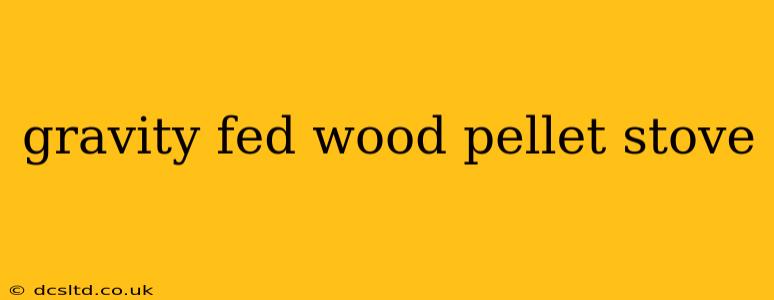Gravity-fed wood pellet stoves offer a unique blend of convenience and efficiency, making them a compelling choice for homeowners seeking supplemental or primary heating. Unlike auger-fed systems that rely on mechanical feeding, gravity-fed stoves utilize the natural force of gravity to dispense pellets from a hopper into the burn pot. This simple yet effective mechanism translates to several advantages, but also presents some considerations. This comprehensive guide delves into the intricacies of gravity-fed wood pellet stoves, exploring their benefits, drawbacks, and everything in between.
How Does a Gravity-Fed Pellet Stove Work?
At the heart of a gravity-fed pellet stove lies its straightforward design. Pellets are stored in a hopper located above the burn pot. Gravity pulls the pellets down through a chute or tube, feeding them into the combustion chamber at a controlled rate. The stove's internal mechanisms regulate the pellet flow, ensuring a consistent burn. Unlike auger systems which use a rotating screw to move the pellets, this gravity system eliminates moving parts in the pellet delivery system, contributing to its often simpler and more robust design.
What are the Advantages of Gravity-Fed Pellet Stoves?
Several key benefits make gravity-fed stoves attractive to consumers:
- Simplicity and Reliability: Fewer moving parts mean fewer potential points of failure. This translates to potentially lower maintenance and a greater likelihood of reliable operation, especially crucial in colder climates where heating is paramount.
- Quiet Operation: The absence of an auger motor results in a quieter operation compared to auger-fed stoves. This makes them ideal for those seeking a peaceful home environment.
- Potential for Lower Cost: While initial purchase price might vary depending on the model, the simplified mechanism can potentially lead to lower repair costs in the long run.
- Less Power Dependence: Some models require less electrical power to operate compared to their auger-fed counterparts, making them more suitable for areas with unreliable power grids.
What are the Disadvantages of Gravity-Fed Pellet Stoves?
While gravity-fed pellet stoves offer several advantages, they also present some drawbacks:
- Lower Output: Generally, gravity-fed stoves tend to have lower BTU output compared to auger-fed models. This means they might not be suitable for heating very large spaces.
- Larger Hopper Required: To achieve a comparable burn time to auger-fed stoves, gravity-fed models often necessitate larger hoppers, which can increase the stove's overall size and footprint.
- Potential for Jams: While infrequent, pellet jams can occur, especially with low-quality pellets or if the pellet chute isn't properly configured.
- Limited Control: Precise control over the burn rate may be less nuanced than in auger-fed stoves, making it more challenging to fine-tune the heat output.
What Size Hopper Do Gravity-Fed Pellet Stoves Have?
The size of the hopper varies significantly between models. You'll find some with relatively small hoppers, requiring more frequent refills, while others boast substantially larger capacities for extended burn times – often measured in hours, sometimes reaching 24 hours or more depending on the burn rate and pellet quality. Always check the manufacturer's specifications for the precise hopper capacity of the model you're considering.
Are Gravity-Fed Pellet Stoves More Efficient?
Efficiency is a complex issue. While the simpler mechanism of a gravity-fed stove can lead to fewer mechanical losses, its overall efficiency in terms of BTU output per pellet burned might not necessarily outperform a well-designed auger-fed system. The ultimate efficiency depends more on factors like the combustion chamber design and the quality of the pellets used rather than the feeding mechanism alone.
How Much Do Gravity-Fed Pellet Stoves Cost?
The cost of a gravity-fed pellet stove can vary widely depending on brand, size, features, and retailer. Prices typically range from a few hundred dollars to several thousand dollars. It's crucial to research various models and compare prices before making a purchase. Remember to factor in the cost of installation as well.
Are Gravity-Fed Pellet Stoves Worth It?
The "worth it" factor depends entirely on your individual needs and priorities. If simplicity, quiet operation, and potentially lower maintenance are your top concerns, a gravity-fed stove could be an excellent choice. However, if you need a high BTU output for a large space or require very precise temperature control, an auger-fed model might be more suitable. Carefully consider your heating requirements and budget before making a decision.
This guide provides a comprehensive overview of gravity-fed wood pellet stoves. Remember to consult with a qualified heating professional to determine the best type of stove for your specific needs and home environment.
